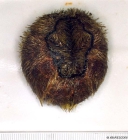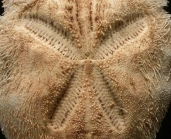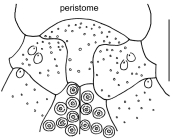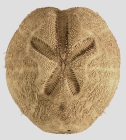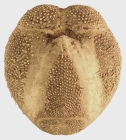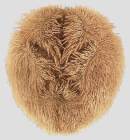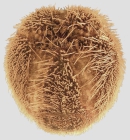Deep-Sea taxon details
Brissopsis lyrifera (Forbes, 1841)
124373 (urn:lsid:marinespecies.org:taxname:124373)
accepted
Species
marine, brackish, fresh, terrestrial
recent only
(of ) Forbes, E. (1841). A history of British Starfishes and other animals of the class Echinodermata. <em>London; John Van Voorst.</em> 267 pp., available online at https://www.biodiversitylibrary.org/page/2061567
page(s): 187-189 [details]
page(s): 187-189 [details]
Distribution From 5 to more than 200 m depth, burrowing in mud or muddy sand, all round the British Isles, except the English Channel
Distribution From 5 to more than 200 m depth, burrowing in mud or muddy sand, all round the British Isles, except the English Channel [details]
Kroh, A.; Mooi, R. (2024). World Echinoidea Database. Brissopsis lyrifera (Forbes, 1841). Accessed through: Glover, A.G.; Higgs, N.; Horton, T. (2024) World Register of Deep-Sea species (WoRDSS) at: https://marinespecies.org/deepsea/aphia.php?p=taxdetails&id=124373 on 2024-04-25
Glover, A.G.; Higgs, N.; Horton, T. (2024). World Register of Deep-Sea species (WoRDSS). Brissopsis lyrifera (Forbes, 1841). Accessed at: https://www.marinespecies.org/deepsea/aphia.php?p=taxdetails&id=124373 on 2024-04-25
original description
(of ) Forbes, E. (1841). A history of British Starfishes and other animals of the class Echinodermata. <em>London; John Van Voorst.</em> 267 pp., available online at https://www.biodiversitylibrary.org/page/2061567
page(s): 187-189 [details]
context source (Deepsea) Mironov A.N. (2014). Deep-sea fauna of European seas: An annotated species check-list of benthic invertebrates living deeper than 2000 m in the seas bordering Europe. Echinoidea. <i>Invertebrate Zoology</i>. Vol.11. No.1: 120–129 [in English]., available online at http://www.nature.air.ru/invertebrates/v11n1/invert11_1_120_129_Echinoidea.pdf [details] Available for editors
basis of record Hansson, H.G. (2001). Echinodermata, <B><I>in</I></B>: Costello, M.J. <i>et al.</i> (Ed.) (2001). <i>European register of marine species: a check-list of the marine species in Europe and a bibliography of guides to their identification. Collection Patrimoines Naturels,</i>. 50: pp. 336-351. (look up in IMIS) [details]
additional source Rowe, F. W. E.; Gates, J. (1995). Echinodermata. <em>In ‘Zoological Catalogue of Australia'.</em> 33 (Ed A. Wells.) pp xiii + 510 (CSIRO Australia, Melbourne). [details]
additional source Southward, E.C.; Campbell, A.C. (2006). [Echinoderms: keys and notes for the identification of British species]. <i>Synopses of the British fauna (new series)</i>, 56. Field Studies Council: Shrewsbury, UK. ISBN 1-85153-269-2. 272 pp. (look up in IMIS) [details]
additional source Mortensen, T. (1951). A Monograph of the Echinoidea. V, 2. Spatangoida II. Amphisternata II. Spatangidæ, Loveniidæ, Pericosmidæ, Schizasteridæ, Brissidæ, 593 pp., C. A. Reitzel, Copenhagen.
page(s): 380-390 [details]
additional source Hansson, H. (2004). North East Atlantic Taxa (NEAT): Nematoda. Internet pdf Ed. Aug 1998., available online at http://www.tmbl.gu.se/libdb/taxon/taxa.html [details] Available for editors
page(s): 187-189 [details]
context source (Deepsea) Mironov A.N. (2014). Deep-sea fauna of European seas: An annotated species check-list of benthic invertebrates living deeper than 2000 m in the seas bordering Europe. Echinoidea. <i>Invertebrate Zoology</i>. Vol.11. No.1: 120–129 [in English]., available online at http://www.nature.air.ru/invertebrates/v11n1/invert11_1_120_129_Echinoidea.pdf [details] Available for editors
basis of record Hansson, H.G. (2001). Echinodermata, <B><I>in</I></B>: Costello, M.J. <i>et al.</i> (Ed.) (2001). <i>European register of marine species: a check-list of the marine species in Europe and a bibliography of guides to their identification. Collection Patrimoines Naturels,</i>. 50: pp. 336-351. (look up in IMIS) [details]
additional source Rowe, F. W. E.; Gates, J. (1995). Echinodermata. <em>In ‘Zoological Catalogue of Australia'.</em> 33 (Ed A. Wells.) pp xiii + 510 (CSIRO Australia, Melbourne). [details]
additional source Southward, E.C.; Campbell, A.C. (2006). [Echinoderms: keys and notes for the identification of British species]. <i>Synopses of the British fauna (new series)</i>, 56. Field Studies Council: Shrewsbury, UK. ISBN 1-85153-269-2. 272 pp. (look up in IMIS) [details]
additional source Mortensen, T. (1951). A Monograph of the Echinoidea. V, 2. Spatangoida II. Amphisternata II. Spatangidæ, Loveniidæ, Pericosmidæ, Schizasteridæ, Brissidæ, 593 pp., C. A. Reitzel, Copenhagen.
page(s): 380-390 [details]
additional source Hansson, H. (2004). North East Atlantic Taxa (NEAT): Nematoda. Internet pdf Ed. Aug 1998., available online at http://www.tmbl.gu.se/libdb/taxon/taxa.html [details] Available for editors
 Present
Present  Inaccurate
Inaccurate  Introduced: alien
Introduced: alien  Containing type locality
Containing type locality
From other sources
Distribution From 5 to more than 200 m depth, burrowing in mud or muddy sand, all round the British Isles, except the English Channel [details]Habitat Known from seamounts and knolls [details]
| Language | Name | |
|---|---|---|
| English | heart urchin | [details] |
| Norwegian Bokmål | lyresjømus | [details] |
| Norwegian Nynorsk | lyresjømus | [details] |
| Swedish | lyrsjöborre | [details] |
BIOTIC
Encyclopedia of Marine Life of Britain and Ireland
Marine Life Information Network - UK
To Barcode of Life (24 barcodes)
To Biodiversity Heritage Library (228 publications)
To Dyntaxa
To European Nucleotide Archive (ENA)
To GenBank (22 nucleotides; 18 proteins)
To MNHN Fossil collection (Brissopsis lyrifera (FORBES, 1841); Figuré; F.R62127)
To PESI
To USNM Invertebrate Zoology Echinodermata Collection (5 records)
To ITIS
Encyclopedia of Marine Life of Britain and Ireland
Marine Life Information Network - UK
To Barcode of Life (24 barcodes)
To Biodiversity Heritage Library (228 publications)
To Dyntaxa
To European Nucleotide Archive (ENA)
To GenBank (22 nucleotides; 18 proteins)
To MNHN Fossil collection (Brissopsis lyrifera (FORBES, 1841); Figuré; F.R62127)
To PESI
To USNM Invertebrate Zoology Echinodermata Collection (5 records)
To ITIS

